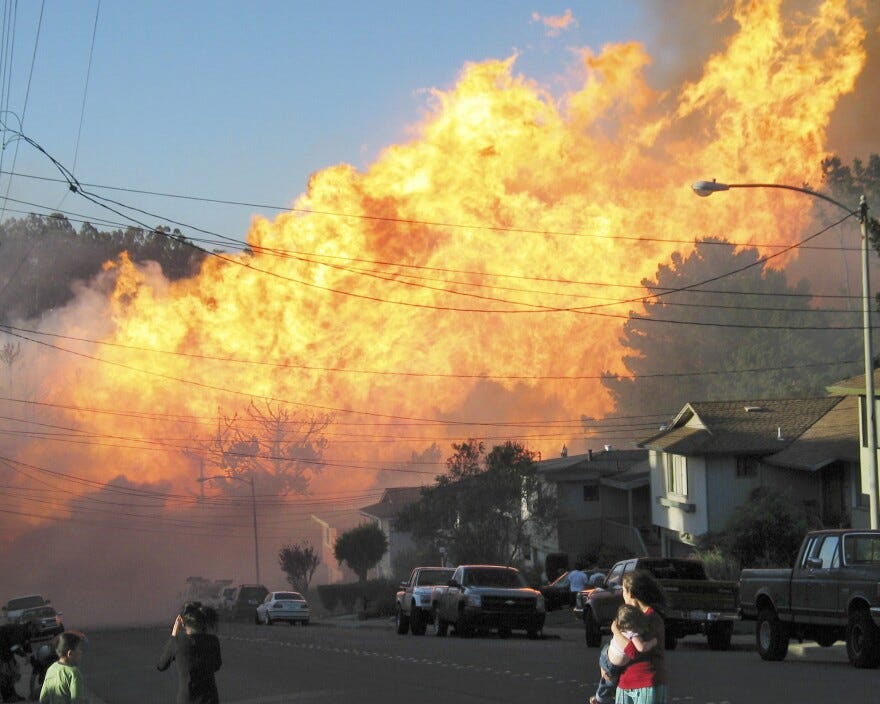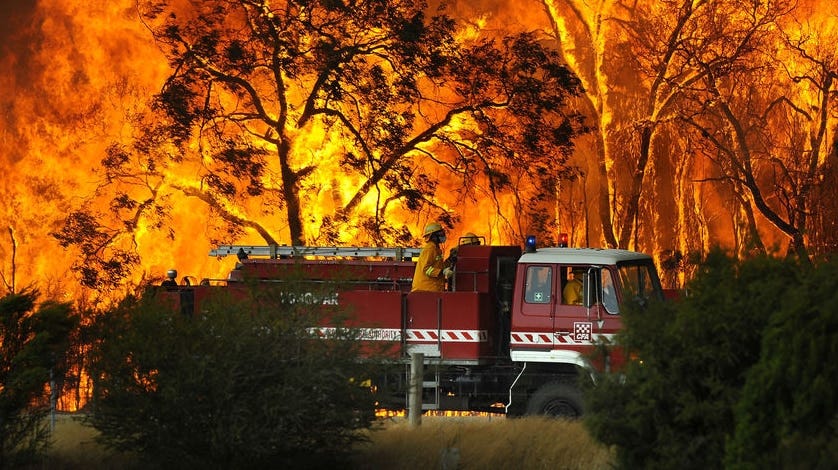At least 115 people have been confirmed dead and more than 1,000 are unaccounted for after devastating fires tore through Maui, Hawaii. By number of deaths already confirmed, it is the worst fire in the USA for more than a century.
In the aftermath of this tragedy, there will be investigations to determine the cause of the blaze. From the early reports, it’s likely that electrical infrastructure was at least partially responsible. If this is found to be true, the Maui fires would become another chapter in the storied connection between electrical utilities and bushfires. Similar events have occurred in California and Australia, with equally calamitous consequences.
Staring into the energy transition, these electrical utilities find themselves in a precarious position. One on hand, they are integral to building the infrastructure needed to replace coal and gas generators with wind and solar. At the same time, the safety risks posed by power lines are being exacerbated by climate change — the likelihood of extreme weather, drought and the conditions for devastating wildfires continue to rise. These utilities and electrical regulators need to balance their resources correctly between ever increasing safety risks and the expansion needed to achieve the energy transition. If they fail, there are grave risks.
The Golden State
“Dozens of people were left behind, unable to escape for reasons that made their gruesome deaths even more tragic… One man had abandoned his wheelchair and tried to drag himself along the ground.” - Katherine Blunt, California Burning.
Prior to the Maui fires, the three worst American bushfires of the past century were in California.1
The worst of these fires was the 2018 Camp Fire, which destroyed the town of Paradise, directly killing 84 people and an 85th person took their life as the fire closed in.
The Camp Fire started when a transmission line owned by Pacific Gas and Electric (PG&E) fell through the hook that was holding it up, sparking upon hitting the ground. That power line was old. It had been build in the early 1900s, made partially with components from manufacturers than haven’t existed for over 80 years.
PG&E on founding was very different to the PG&E who faced court over the Camp Fire.
In the spirit of the pioneering west coast, it was a couple of entrepreneurs that started the foundations that would eventually go on to become the behemoth utility. In the late 1890s, PG&E was formed by John Martin and Eugene J de Sabla. These two men, who had been gold miners on the Yuba River, scrapped together enough cash to start building electrical infrastructure to bring the output of the new hydroelectric power stations to cities like San Francisco.
Over time and with some mergers and acquisitions, PG&E grew into the dominant gas and electric distributor in the northern half of the state. At this point in history, the owners of poles and wires would compete for customers. However, regulators and policy makers decided that, instead of competition, it would be more effective and cost-efficient to designate various utilities as monopoly providers, including PG&E. PG&E was given exclusive rein over the distribution of power in northern California. In exchange for being freed from competition, PG&E was required to have its revenue allowance determined by regulators, and meet other standards set by the regulator.
In the early 2000s, PG&E was swept up in the disastrous early deregulation of the Californian electricity market. As wholesale electricity prices skyrocketed, PG&E was required to onsell electricity to its customers at a capped rate. Soaring costs and capped revenue drove PG&E to bankruptcy, ultimately costing the company and the state of California close to $45 billion.
However, the problems that led to the Camp Fire are most closely tied back to internal shifts in strategy. Around the turn of the century, PG&E tried to make itself more attractive to investors. It brought in management consultants who pushed the business to reorient itself away toward more profitable endeavours. This included a clunky transition from paper-based offices to digital infrastructure, during which scores of records went missing. It also included a reallocation of spending from maintenance to capital expenditure.2
The first major consequence of the reduced focus on safety arose in PG&E’s gas division. On 9 September, 2010, a gas pipeline exploded, killing eight people. PG&E settled with victims, having failed to assess the pipeline adequately as its maintenance programs sought to reduce costs.
All the while, the risks were growing inland in northern California. The risks of bushfires were always pronounced in southern California, but considered less likely in the north. For this reason, PG&E was able to argue that it was not required to comply with the more stringent measures for managing fire risks. However, the conditions in northern California were not as they used to be. Droughts left the landscape dry. The forests were weakened and millions of trees were being killed off by bark beetles. Increasing temperatures created stronger winds. Eventually, on 8 November 2018, the ageing transmission hook snapped.
In the aftermath, it became clear that PG&E and the electrical regulator had failed to properly ensure the line was adequately maintained. Because of the age of the infrastructure, there should have efforts to investigate and replace faulty, worn parts. However, due partially to the lost documentation, efforts to reduce maintenance spending, and under-resourcing at the regulator, this did not occur. Instead, the inspections of the line leading up to the fire occurred from a helicopter, where it was likely impossible to observe the precariously worn hook.
The liabilities from the fire (alongside other bushfires linked to PG&E lines) reached as much as $30 billion. For the second time in less than 20 years, PG&E entered bankruptcy proceedings. Hedge funds and the state were first to settle, taking $12 billion. This meant there wasn’t enough money left to settle with the victims. Cruelly, the victim settlement was partially cash, partially PG&E stock. On 16 June 2020, PG&E pleaded guilty to 84 counts of involuntary manslaughter.
In the years that followed, the fires did not stop. To manage the risk of fires, PG&E turned to shutting off lines when the winds and temperatures picked up. Millions of customers have been left without access to power for days at a time, imposing different costs on the people of California. PG&E now has ambitious plans to shift its lines underground to reduce the fire risk. This might work, but it will likely be expensive and again, it will be ordinary Californians left to pick up the tab.
Black Saturday
“We have a fire at the Old Mill. It’s getting into the dry grass and heading for the trees… we need help immediately” R. Philpott, Murrindindi CFA Captain.
“My mobile phone rang - it was my brother Mike ringing from Perth - he said "G'day Russ, how are you going?" I said "Mike, we're at Marysville, in the car, watching the house burn with the dogs and cat in it and also watching Harley's house burn with him and Errol inside and I don't know if we are going to make it" - then the phone dropped out.” Russell Glenn, survivor of the Black Saturday bushfires.
Black Saturday was the deadliest fire on record in Australia. On Saturday, 7 February 2009, as many as 400 fires burned across Victoria, killing 173 people.
The conditions leading up to Black Saturday signalled disaster. Hot winds exceeded speeds of 100km/hr, accompanied by extreme temperatures and low humidity. Melbourne itself reached 46.4C. Around midday, winds tore a powerline from its tower, starting the Kilmore East fire, which would go on to cause 119 fatalities. Separately, the Murrindindi/Marysville fire, also caused by a failed conductor, caused 40 deaths.
According to the findings on the subsequent Royal Commission into the bushfires, the Kilmore East fire started after a conductor failed on a single wire, earth return (SWER) line owned by the utility SP Ausnet. When the conductor failed, the automatic recloser on the line tried to restore power three times, causing plasma at temperatures of 5,000C to be ejected. The Royal Commission was unable to establish the cause of the Murrindindi fire though, with some suspecting arson.
Again, a takeaway from this tragedy was the inadequate level of inspection and maintenance in bushfire prone areas. The Royal Commission made a number of recommendations, including requiring line upgrades, more regular inspections and better planning for bushfire risks.3 It also came down on Energy Safe Victoria, recommending the regulator receive a stronger mandate to prevent and mitigate against electricity caused bushfires. However, the Royal Commission did not seek to apportion blame for the fires, not wanting to prejudice any criminal trials.
Without admitting any liability, SP Ausnet agreed to a class action settlement of ~$400M in 2015. SP Ausnet maintained that the conductor failure was not due to poor maintenance but instead due to the impact of lightning.
Later in 2015, State Coroner Ian Gary delivered findings from his inquiry, specifically looking into the cause of the Murrindini fire. SP Ausnet has argued that their line had not caused the fire — instead, the conductor had short-circuited because of the impact of pre-existing fires. The Coroner disagreed with SP Ausnet, finding that the fire was started by their power line. He also noted that SP Ausnet’s records of repair work on the faulty line were unable to be located upon his request.
In 2017, the Grimes Review was undertaken, looking into “the design and adequacy of the safety regulatory obligations, incentives and other arrangements governing the safety of the electricity.” It also made recommendations, including better management of conflicts of interest, where staff had previous experience working at the electrical utilities.
Across the multiple views and inquiries, it was made clear. The approach managing electrical distribution through bushfire prone areas had not been good enough.
Maui fires and the future
“Sometime after midnight, a man staggered out from the burning homes, toward a Shell gas station. His shorts were smoldering. Skin was peeling from his face. He collapsed on the pavement.” Washington Post, covering the Maui fires.
And most recently, Maui. If it was powerlines that ignited the fires on Maui, there are clear parallels to California. In 2019, Hawaiian Electric put out a statement that they needed to reduce the risk of wildfires. However, despite making plans to increase its maintenance and tree trimming, it had made very little progress on these plans before this month’s fires. Detailed investigations and class action lawsuits are soon to follow.
As the climate changes, so will the risk profiles for all manner of infrastructure. Our electrical system will need to be designed for a new range of conditions and challenges.
Bushfires are most likely going to get worse. Australia is currently staring down the potential of a hot, dry summer. More extreme climate will mean hotter, drier and more windy conditions.
Transmission and distribution businesses and electrical regulators have a fine line to tread. On one hand, they will need to manage the growing potential for electrical infrastructure to cause fires. On the other, they must plan, build and operate the many kilometres of new lines needed to carry renewable electricity across the country.
There are questions that should be front of mind for regulators, utilities and civilians across the world — have we got the incentives to properly maintain the network? What about the planning arrangements? Are they accounting for the changing risk profiles of our evolving climate? And what about the ability of regulators to assess how well the utilities are performing their duties? These are challenging questions. A lot rides of getting them right.
Things happen
The NSW Government is considering extending the life of Eraring Power Station. This comes on the heels of the Victorian Government agreeing with AGL that Loy Yang A should be kept open until mid 2030s.
AGL fired up the second biggest battery in Australia — the 250 MW/250 MWh Torrens Island BESS in Adelaide. The biggest battery is Australia is still the imaginatively named 300 MW Victorian Big Battery outside Geelong.
Most of this section I learned from the brilliantly written book California Burning: The Fall of Pacific Gas & Electric by Katherine Blunt. I have a copy of this book and I’m very happy to lend it out!
Without getting too far into the details, the way these businesses make money is mostly through investing capital into infrastructure. Very little is made in operating expenses, including maintenance.
A direct outcome of the Black Saturday fires was also the Victorian Bushfire Safety Program which determined that fallen powerlines could initiate bushfires. The Rapid Earth Fault Current Limiter (REFCL) program which saw the mandatory installation of these devices in bushfire-prone areas in order to mitigate bushfire risk. REFCLs operate by rapidly disconnecting lines when a powerline has fallen to the ground.










Great read Declan, slightly terrifying but interesting none the less. I hope all of your questions are answered and quickly.